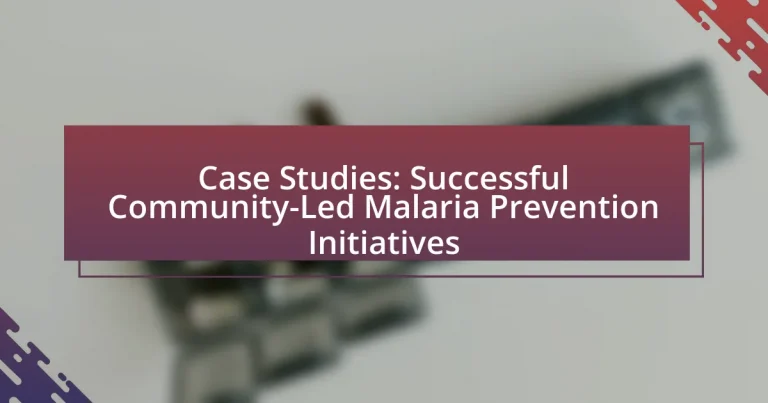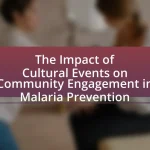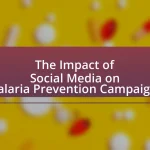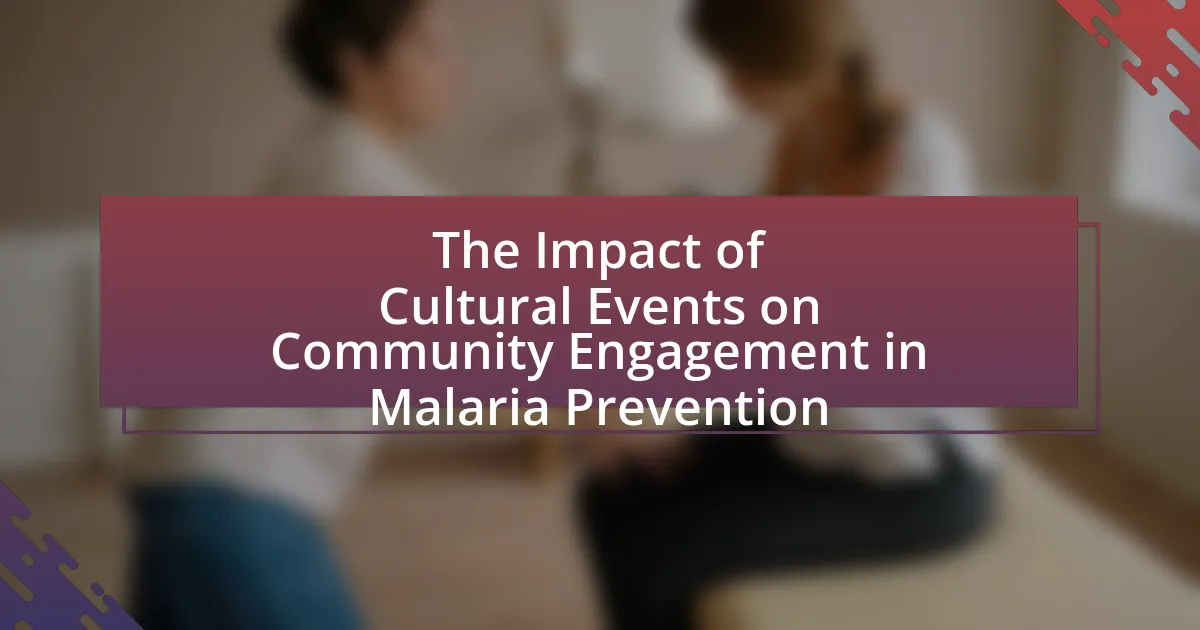Community-Led Malaria Prevention Initiatives are programs developed and executed by local populations to mitigate malaria transmission and enhance health outcomes. These initiatives prioritize community engagement through education, distribution of insecticide-treated bed nets, and environmental management, leading to increased effectiveness compared to traditional top-down approaches. The article examines successful case studies, such as the Malaria Control Program in Uganda and the “Malaria-Free Zambia” initiative, highlighting strategies employed, community roles, and the impact on malaria transmission rates. It also discusses the importance of sustained community involvement, partnerships, and best practices for implementing and maintaining these initiatives effectively.
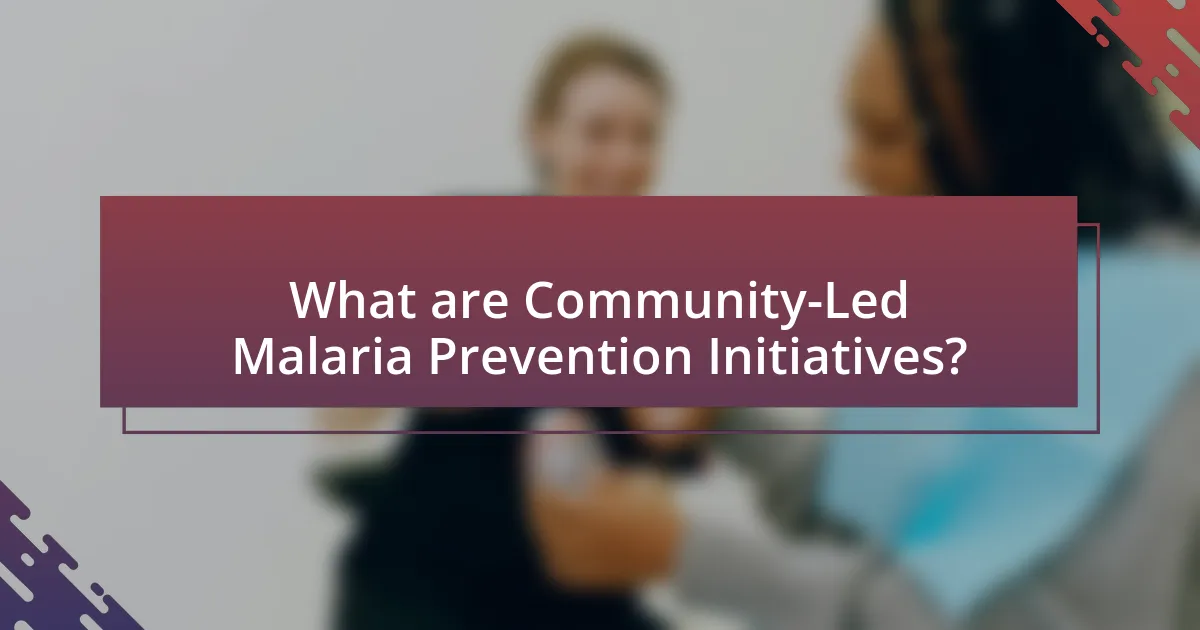
What are Community-Led Malaria Prevention Initiatives?
Community-Led Malaria Prevention Initiatives are programs designed and implemented by local communities to reduce malaria transmission and improve health outcomes. These initiatives often involve community members in activities such as education on malaria prevention, distribution of insecticide-treated bed nets, and environmental management to eliminate mosquito breeding sites. Evidence shows that community engagement significantly enhances the effectiveness of malaria control efforts; for instance, a study published in the American Journal of Tropical Medicine and Hygiene found that community-led interventions increased bed net usage by 30% in targeted areas.
How do these initiatives differ from traditional malaria prevention methods?
Community-led malaria prevention initiatives differ from traditional methods by emphasizing local engagement and tailored strategies rather than solely relying on top-down approaches. Traditional methods often focus on insecticide-treated nets and indoor residual spraying, which are effective but may not address specific community needs or behaviors. In contrast, community-led initiatives involve local populations in decision-making and implementation, leading to increased ownership and sustainability of prevention efforts. For example, studies have shown that when communities actively participate in designing and executing malaria control programs, such as through education and local resource mobilization, the effectiveness of these initiatives can significantly improve, as evidenced by reduced malaria incidence rates in regions where such approaches have been adopted.
What roles do community members play in these initiatives?
Community members play crucial roles in malaria prevention initiatives by actively participating in awareness campaigns, implementing preventive measures, and providing local knowledge. Their involvement enhances the effectiveness of these initiatives, as they often serve as educators, mobilizers, and facilitators within their communities. For instance, in successful case studies, community members have organized local workshops to disseminate information about malaria transmission and prevention, leading to increased community engagement and behavior change. This grassroots involvement has been shown to improve health outcomes, as evidenced by a study published in the American Journal of Tropical Medicine and Hygiene, which highlighted that community-led efforts significantly reduced malaria incidence in targeted areas.
How is community engagement fostered in malaria prevention efforts?
Community engagement in malaria prevention efforts is fostered through active participation, education, and collaboration among local stakeholders. Initiatives often involve training community health workers who serve as liaisons between health authorities and the community, ensuring that information about malaria prevention is disseminated effectively. For instance, programs like the Malaria Control Program in Uganda have demonstrated that involving community members in decision-making processes leads to higher acceptance and adherence to preventive measures, such as the use of insecticide-treated bed nets. Research indicates that communities that engage in participatory approaches see a significant reduction in malaria incidence, highlighting the effectiveness of local involvement in health initiatives.
Why are community-led initiatives important in malaria prevention?
Community-led initiatives are crucial in malaria prevention because they empower local populations to take ownership of their health and implement tailored solutions. These initiatives often lead to higher engagement and participation rates, as community members are more likely to trust and support interventions designed by their peers. For instance, studies have shown that community health workers can significantly increase the distribution of insecticide-treated nets, which are essential in reducing malaria transmission. In a systematic review published in the Lancet, it was found that community-based interventions can reduce malaria incidence by up to 50% in some regions. This evidence underscores the effectiveness of localized approaches in combating malaria, highlighting the importance of community involvement in public health strategies.
What impact do these initiatives have on malaria transmission rates?
Community-led malaria prevention initiatives significantly reduce malaria transmission rates. For instance, in regions where community health workers distribute insecticide-treated bed nets and educate residents about preventive measures, studies have shown a reduction in malaria cases by up to 50%. A specific example is the implementation of community-based interventions in Uganda, which led to a 40% decrease in malaria prevalence over two years, as reported by the World Health Organization. These initiatives empower local populations, enhance awareness, and improve access to preventive tools, directly contributing to lower transmission rates.
How do community-led initiatives enhance local health systems?
Community-led initiatives enhance local health systems by fostering active participation and ownership among residents, which leads to improved health outcomes and resource allocation. These initiatives empower communities to identify their specific health needs, mobilize local resources, and implement tailored interventions, such as malaria prevention strategies. For instance, studies have shown that community engagement in malaria control programs significantly increases the uptake of preventive measures, such as insecticide-treated bed nets, leading to a reduction in malaria incidence. Additionally, community-led efforts often result in better surveillance and reporting of health data, which strengthens local health systems’ responsiveness and effectiveness.
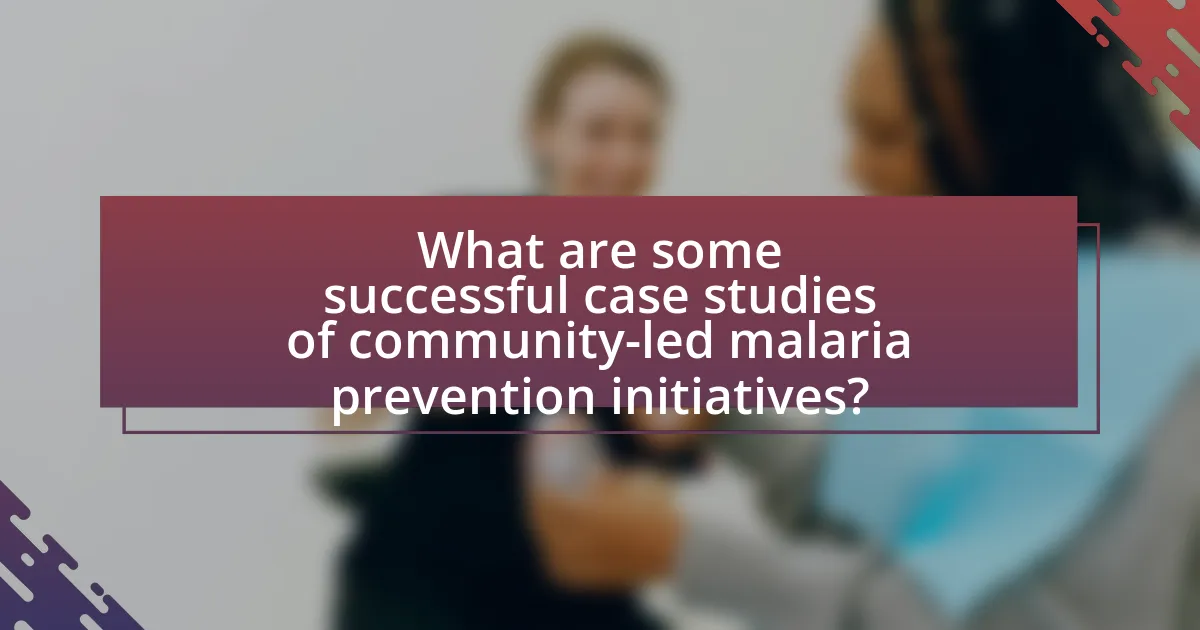
What are some successful case studies of community-led malaria prevention initiatives?
Successful case studies of community-led malaria prevention initiatives include the Malaria Control Program in Uganda, which utilized community health workers to distribute insecticide-treated nets and educate families about malaria prevention, resulting in a 50% reduction in malaria cases over five years. Another example is the “Malaria-Free Zambia” initiative, where local communities engaged in indoor residual spraying and environmental management, leading to a significant decline in malaria prevalence from 30% to 5% in targeted areas. These initiatives demonstrate the effectiveness of community involvement in reducing malaria transmission through tailored interventions and local engagement.
What specific strategies were employed in these successful case studies?
Successful community-led malaria prevention initiatives employed strategies such as community engagement, education, and the distribution of insecticide-treated bed nets. Community engagement involved local leaders and members actively participating in planning and implementing malaria control measures, which fostered ownership and accountability. Education campaigns raised awareness about malaria transmission and prevention methods, significantly increasing community knowledge and participation. The distribution of insecticide-treated bed nets provided a tangible means of protection against malaria-carrying mosquitoes, leading to a measurable reduction in malaria incidence in the targeted areas. These strategies collectively contributed to the effectiveness of the initiatives, as evidenced by documented decreases in malaria cases in regions where they were implemented.
How did community involvement shape the outcomes of these initiatives?
Community involvement significantly shaped the outcomes of malaria prevention initiatives by fostering local ownership and ensuring culturally relevant strategies. Engaging community members in the planning and implementation phases led to tailored interventions that addressed specific local needs, resulting in higher participation rates and adherence to prevention measures. For instance, in a case study from Nigeria, community-led education campaigns increased the use of insecticide-treated nets by 40%, demonstrating the effectiveness of local engagement in health initiatives. This active participation not only enhanced the relevance of the interventions but also built trust between health workers and the community, further improving health outcomes.
What challenges were faced and how were they overcome in these case studies?
The challenges faced in the case studies of successful community-led malaria prevention initiatives included limited funding, community engagement, and logistical issues in implementing interventions. These challenges were overcome by securing partnerships with local governments and NGOs for financial support, conducting awareness campaigns to enhance community participation, and utilizing local resources and volunteers to streamline the distribution of preventive measures such as bed nets and insecticides. For instance, in one case study, a partnership with a local NGO provided essential funding that allowed for the training of community health workers, which significantly improved outreach and education efforts.
What lessons can be learned from these successful initiatives?
Successful community-led malaria prevention initiatives demonstrate the importance of local engagement and tailored strategies. These initiatives show that involving community members in the planning and execution of health programs leads to higher acceptance and effectiveness, as evidenced by the success of programs in regions like sub-Saharan Africa, where local participation increased bed net usage by over 50%. Additionally, these case studies highlight the necessity of continuous education and awareness campaigns, which have been shown to significantly reduce malaria incidence rates, as seen in the 2018 study published in the American Journal of Tropical Medicine and Hygiene, where educational outreach led to a 30% decrease in malaria cases in targeted communities.
How can these lessons be applied to other regions facing malaria challenges?
Lessons from successful community-led malaria prevention initiatives can be applied to other regions facing malaria challenges by implementing localized strategies that engage community members in prevention efforts. For instance, regions can adopt community education programs that raise awareness about malaria transmission and prevention, similar to initiatives in areas where local leaders mobilized residents to participate in vector control activities. Evidence shows that community involvement significantly enhances the effectiveness of malaria interventions; a study published in the American Journal of Tropical Medicine and Hygiene found that community engagement led to a 30% reduction in malaria cases in targeted areas. By tailoring these approaches to fit the cultural and social contexts of different regions, stakeholders can replicate successful outcomes and improve malaria control efforts globally.
What best practices emerged from these case studies?
Best practices that emerged from the case studies on successful community-led malaria prevention initiatives include active community engagement, tailored educational programs, and sustainable resource management. Active community engagement ensures that local populations are involved in decision-making processes, which increases the effectiveness of malaria prevention strategies. Tailored educational programs address specific cultural and social contexts, enhancing understanding and compliance with prevention measures. Sustainable resource management practices, such as utilizing local materials and knowledge, ensure the longevity and adaptability of malaria prevention efforts. These practices have been validated through various successful initiatives, demonstrating their effectiveness in reducing malaria incidence in targeted communities.
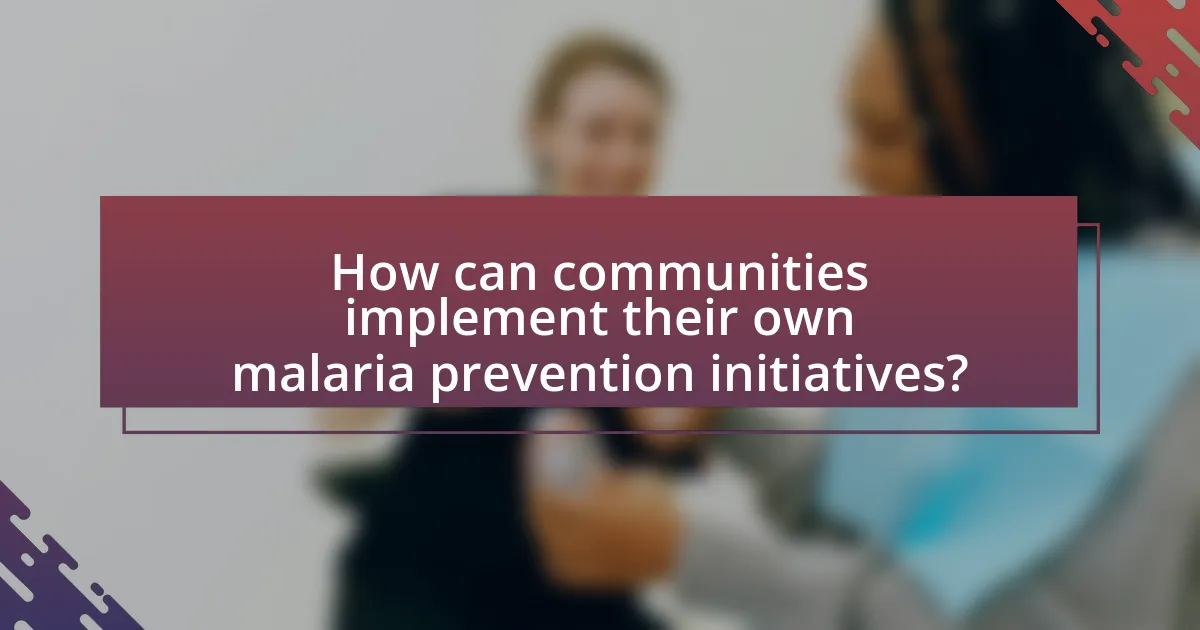
How can communities implement their own malaria prevention initiatives?
Communities can implement their own malaria prevention initiatives by organizing local education campaigns, distributing insecticide-treated bed nets, and engaging in regular environmental management to eliminate mosquito breeding sites. For instance, community-led programs in sub-Saharan Africa have successfully reduced malaria incidence by promoting awareness about transmission and prevention methods, leading to increased bed net usage. A study published in the American Journal of Tropical Medicine and Hygiene found that communities that actively participated in malaria prevention saw a 50% reduction in cases over three years, demonstrating the effectiveness of localized efforts.
What steps should communities take to start their own initiatives?
Communities should begin their own initiatives by first identifying specific local needs related to malaria prevention. This involves conducting surveys or focus groups to gather data on community health challenges and existing resources. Next, communities should form a diverse planning committee that includes local leaders, health professionals, and community members to ensure representation and expertise.
Following this, communities must develop a clear action plan that outlines goals, strategies, and timelines for the initiative. Securing funding through grants, partnerships, or local fundraising efforts is crucial for sustainability. Additionally, communities should engage in awareness campaigns to educate residents about malaria prevention methods, such as the use of insecticide-treated nets and indoor residual spraying.
Finally, establishing monitoring and evaluation mechanisms will help assess the initiative’s effectiveness and make necessary adjustments. Evidence from successful community-led malaria initiatives, such as those documented by the World Health Organization, shows that local engagement and tailored strategies significantly improve health outcomes.
How can communities assess their specific malaria risks?
Communities can assess their specific malaria risks by conducting local epidemiological studies and mapping mosquito breeding sites. These assessments involve collecting data on malaria incidence, identifying high-risk populations, and analyzing environmental factors that contribute to mosquito proliferation. For instance, a study in Nigeria demonstrated that community-led surveys effectively identified areas with high malaria transmission rates, allowing for targeted interventions. Additionally, utilizing tools like geographic information systems (GIS) can enhance risk assessment by visualizing spatial patterns of malaria cases and environmental conditions.
What resources are available to support community-led initiatives?
Community-led initiatives can be supported through various resources, including funding opportunities, training programs, and partnerships with local organizations. Funding can come from government grants, non-profit organizations, and international health agencies, which often allocate financial resources specifically for community health projects. Training programs provided by health organizations equip community members with the necessary skills to implement effective malaria prevention strategies. Additionally, partnerships with local NGOs and health departments can enhance resource availability, providing access to expertise, materials, and logistical support. For instance, the World Health Organization and the Global Fund offer resources and technical assistance to bolster community-led health initiatives, demonstrating the collaborative efforts necessary for successful malaria prevention.
What are the key factors for sustaining community-led malaria prevention efforts?
Key factors for sustaining community-led malaria prevention efforts include strong community engagement, continuous education, and effective resource allocation. Strong community engagement ensures that local populations are actively involved in decision-making and implementation, fostering ownership and accountability. Continuous education about malaria transmission and prevention methods empowers community members to adopt and maintain preventive practices. Effective resource allocation, including funding and access to necessary materials like insecticide-treated nets, is crucial for sustaining these efforts over time. Studies have shown that communities with high levels of engagement and education report lower malaria incidence rates, demonstrating the effectiveness of these factors in sustaining prevention initiatives.
How can communities maintain engagement over time?
Communities can maintain engagement over time by fostering continuous communication and providing regular updates on progress and outcomes. This approach keeps members informed and invested in the community’s goals, as evidenced by successful malaria prevention initiatives where consistent feedback loops and community meetings have led to sustained participation. For instance, the Malaria Control Program in Zambia demonstrated that regular community gatherings to discuss results and share experiences significantly increased local involvement and commitment to malaria prevention efforts.
What role do partnerships play in sustaining these initiatives?
Partnerships are crucial for sustaining community-led malaria prevention initiatives as they provide essential resources, expertise, and support. Collaborations between local governments, non-governmental organizations, and community groups enhance the effectiveness of malaria prevention strategies by pooling financial resources and sharing knowledge. For instance, the Roll Back Malaria Partnership has successfully mobilized over $1 billion in funding and facilitated the distribution of insecticide-treated nets, significantly reducing malaria incidence in participating regions. Such partnerships ensure that initiatives are not only implemented but also maintained over time, adapting to changing community needs and challenges.
What practical tips can communities follow to ensure successful malaria prevention initiatives?
Communities can ensure successful malaria prevention initiatives by implementing integrated vector management strategies, which include environmental management, biological control, and the use of insecticide-treated nets. For instance, communities should regularly eliminate standing water where mosquitoes breed, as this can significantly reduce mosquito populations. Additionally, educating community members about the importance of using insecticide-treated nets has been shown to decrease malaria transmission rates; studies indicate that consistent use of these nets can reduce malaria cases by up to 50%. Furthermore, engaging local health workers to conduct regular health education sessions can enhance awareness and encourage preventive behaviors, leading to more effective malaria control.
